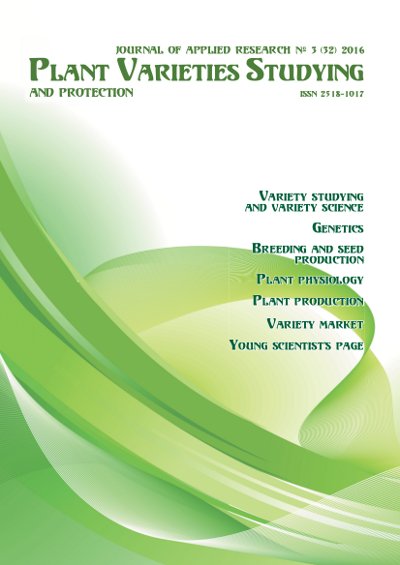Evaluation of the relationship of sowing qualities and yielding properties of millet seed (Panicum meliaceum L.).
DOI:
https://doi.org/10.21498/2518-1017.3(32).2016.75982Keywords:
millet, seeds, maternal plants, the first seed progeny, fertilizers, trait-indicator, correlation pleiadeAbstract
Purpose. Determination and analysis of relationship of sowing qualities and yield properties of millet seed (Panicum meliaceum L.) to be formed by the action of predecessors and conditions of mineral nutrition in the context of unstable moistening in the Right-Bank Forest-Steppe zone of Ukraine.
Methods. Mathematico-statistical ones (correlation, regression).
Results. The use of correlation pleiades method allowed to analyze multifactor relations of sowing qualities and yield properties of millet seed and establish that there was a direct correlation relationship of medium strength (r = 0.52 ± 0.01) between yielding of maternal and millet plants of the first seed progeny. It was found that maternal plants yielding is strongly correlated with laboratory and technological indicators of seed quality that interrelated through integrated quality parameter of seed material (r = 0.56 ± 0.01) and millet output (r = 0.98 ± 0.00). Integrated quality parameter as well as each of the studied laboratory parameters of seed material quality taken separately have a high-level (r = 0.87…0.96 ± 0.00) effect on the formation of grain yield of the first seed progeny plants. Such physical and technological parameters of the quality of maternal plants yield as a content of protein and fat in seed, seed weight, its uniformity can directly, and millet output, thousand-grain weight and hull content – indirectly indicate peculiarities of forming future grain yield of plants of the first seed progeny.
Conclusions. The use of the correlation pleiades method allows to analyze objectively the sowing qualities of millet seed and predict the yield properties in the next generation.
Downloads
References
Anderson, J. R., & Hazell, P. B. R. (eds). (1989). Variability in grain yields: implications for agricultural research and policy in developing countries. Baltimore: Johns Hopkins University Press.
Harrington, J. F. (1973). Biochemical basis of seed longevity. Seed Sci. Technol., 1, 453–461.
Kalenska, S. M. (2008). Global trends in the development of seed industry. Naukovi pratsi Pivdennoho filialu Natsionalnoho universytetu bioresursiv i pryrodokorystuvannia Ukrainy ″Krymskyi ahrotekhnolohichnyi universytet″. Seriia: Silskohospodarski nauky [Proceedings of the Southern Branch of the National university of life and environmental sciences of Ukraine “Crimean agrotechnological university”. Series: Agricultural sciences], 107, 26–32. [in Ukrainian]
Terent’ev, P. V. (1960). Further development of the correlation pleiades method. In Primenenie matematicheskikh metodov v biologii [The application of mathematical methods in biology]. (pp. 27–36). Leningrad: Izdatelstvo LGU. [in Russian]
Borovikov, V. P. (2003). Statistica. Iskusstvo analiza dannykh na komp’yutere: dlya professionalov [Statistica. The art of computer data analysis: for professionals]. (2nd ed.). St. Petersburg: Piter. [in Russian]
Honchar, O. M. (Ed.). (2010). Metodyka derzhavnoho sortovyprobuvannia silskohospodarskykh kultur [Methodology of state variety testing of agricultural crops]. Vol. 7: Methods of determining indicators of agricultural products quality. Kyiv: Alefa. [in Ukrainian]
Poltoretskyi, S. P. (2014) Effect of predecessors and fertilizers on yield and quality of millet seeds. Vestnik Krasnoyarskogo GAU [Bulletin of Krasnoyarsk State Agrarian University], 6, 109–115. [in Russian]
Poltoretskyi, S. P., & Poltoretska, N. M. (2015). The yield and quality of millet grain depending on the predecessor and fertilizing conditions. Visn. agrar. nauki Pričornomor’â [Ukrainian Black Sea region agrarian science], 2(1, 2), 73–82. [in Ukrainian]
Downloads
Published
How to Cite
Issue
Section
License
Copyright (c) 2016 Ukrainian Institute for Plant Variety Examination

This work is licensed under a Creative Commons Attribution-ShareAlike 4.0 International License.
Starting in 2022, the copyright to the publication remains with the authors
Our journal abides by the CREATIVE COMMONS copyright rights and permissions for open access journals.
Authors, who are published in this journal, agree to the following conditions:
- The authors reserve the right to authorship of the work and pass the first publication right of this work to the journal under the terms of a Creative Commons Attribution License, which allows others to freely distribute the published research with the obligatory reference to the authors of the original work and the first publication of the work in this journal.
- The authors have the right to conclude separate supplement agreements that relate to non-exclusive work distribution in the form in which it has been published by the journal (for example, to upload the work to the online storage of the journal or publish it as part of a monograph), provided that the reference to the first publication of the work in this journal is included.

























 Ukrainian Institute for Plant Varieties Examination
Ukrainian Institute for Plant Varieties Examination  Селекційно-генетичний інститут
Селекційно-генетичний інститут Institute of Plant Physiology and Genetics of the National Academy of Sciences of Ukraine
Institute of Plant Physiology and Genetics of the National Academy of Sciences of Ukraine
 The National Academy of Agrarian Sciences of Ukraine
The National Academy of Agrarian Sciences of Ukraine